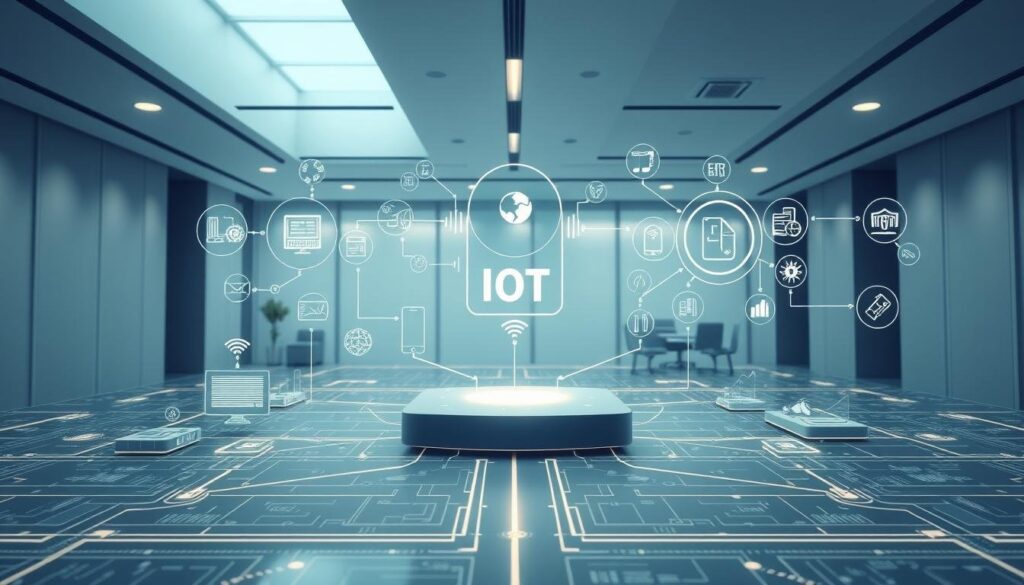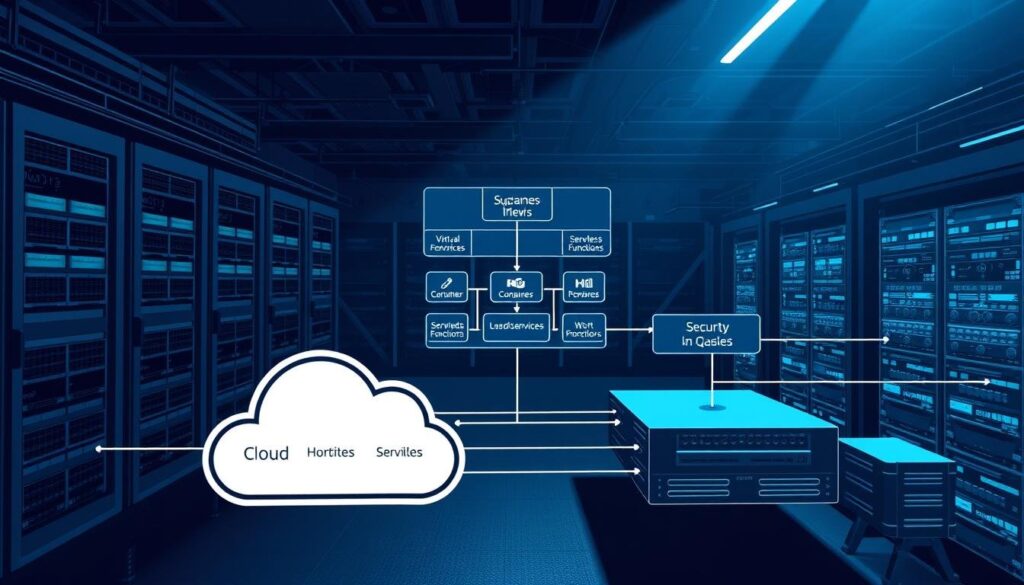Could your company be sitting on a goldmine of untapped data? The Internet of Things (IoT) transforms everyday devices into powerful tools for driving smarter decisions. By 2025, businesses that harness this technology will redefine how they operate, innovate, and connect with customers.

IoT goes beyond connecting gadgets—it turns raw data into actionable insights. Imagine production lines predicting maintenance needs or retail stores adjusting inventory based on real-time customer behavior. These scenarios aren’t futuristic dreams. They’re happening now.
For leaders, IoT represents a strategic advantage. It merges physical operations with digital systems, creating responsive ecosystems. This shift moves organizations from reactive problem-solving to proactive optimization. Costs drop. Efficiency rises. New revenue streams emerge.
Key Takeaways
- IoT bridges physical assets and digital systems for smarter decision-making
- Real-time data analysis enables proactive operational adjustments
- Cross-industry applications reduce costs while boosting innovation
- Connected ecosystems create competitive advantages in customer experience
- Strategic IoT adoption drives measurable ROI through process optimization
Understanding the Fundamentals of IoT Technology
Modern enterprises leverage interconnected systems to drive operational intelligence. These networks combine physical devices with digital interfaces, creating ecosystems where data flows seamlessly between objects and systems.

From Basic Tools to Smart Solutions
Early connected devices focused on simple data transmission. Today’s advanced versions process information locally using edge computing. This evolution allows machinery to adjust operations autonomously—like HVAC units optimizing energy use based on occupancy patterns.
Core Building Blocks
Three elements power these intelligent technologies:
- Sensors: Detect environmental changes (temperature shifts, equipment vibrations)
- Actuators: Trigger physical responses (valve adjustments, motor speed changes)
- Connectivity: Enables real-time data exchange through secure networks
Pressure sensors in manufacturing lines exemplify this synergy. They identify abnormal vibrations and signal actuators to recalibrate machinery—preventing downtime before failures occur. Such integrations turn standard tools into self-monitoring assets.
Dropping component costs now make these solutions accessible. Retailers use motion-detecting shelves to track inventory, while logistics firms employ GPS-enabled trackers. The barrier to entry has vanished for businesses ready to modernize.
Integrating what is IoT into Strategic Business Decisions
Forward-thinking organizations now convert raw sensor outputs into boardroom strategies. By embedding connected technologies into core processes, teams gain unprecedented clarity across supply chains, workflows, and customer interactions.

Data-Driven Insights for Operational Efficiency
Real-time data integration transforms how companies respond to challenges. Manufacturing teams using vibration sensors cut equipment downtime by 43% in one case study. Retailers tracking foot traffic patterns optimize staff schedules within 2% margin of error.
Three critical advantages emerge when aligning connected systems with corporate goals:
- Dynamic inventory management using shelf sensors and demand forecasting
- Energy consumption optimization through smart building controls
- Predictive maintenance schedules based on equipment performance analytics
These applications demonstrate how continuous data streams enable proactive adjustments. One logistics provider reduced fuel costs by 18% after integrating GPS trackers with route-planning software. The key lies in merging IoT outputs with existing business systems through unified dashboards.
Effective implementation requires robust governance frameworks. We help clients establish protocols for data accuracy, security, and cross-departmental accessibility. This ensures insights drive measurable improvements rather than creating information overload.
Navigating IoT Solutions and Use Cases
Innovative companies are transforming maintenance strategies with predictive analytics. Modern operations now rely on interconnected systems that turn raw data into strategic action plans. These solutions bridge physical assets with digital intelligence, creating adaptable workflows across industries.
Remote Monitoring and Predictive Maintenance
Monitoring systems track equipment health from oil rigs to dairy farms. Vibration sensors detect bearing wear in wind turbines weeks before failure. Temperature gauges in refrigerated trucks trigger alerts when thresholds breach. One manufacturer reduced repair costs by 37% using these real-time insights.
Predictive maintenance takes this further. Machine learning analyzes historical patterns and live data streams. Algorithms forecast pump failures with 92% accuracy in water treatment plants. This shift from calendar-based checks to condition-based servicing slashes downtime by up to 45%.
Smart Facilities and Connected Products Applications
Office buildings now self-regulate environments using occupancy sensors. Lights dim in empty conference rooms while HVAC adjusts to crowd density. A tech campus cut energy bills by 28% after implementing these solutions.
Connected products unlock service-based revenue streams. Fitness trackers suggest personalized workouts while transmitting usage data to developers. Industrial printers automatically order ink before running dry. These applications create ongoing customer relationships beyond initial sales.
As one logistics director noted: “Our GPS-enabled pallets reduced shipment losses by 63% last quarter.” Such use cases prove that strategic IoT adoption delivers measurable ROI through smarter asset management.
Industrial IoT and Digital Manufacturing Advancements
Factories now achieve 23% higher output through intelligent machine networks. This leap forward stems from industrial IoT solutions that merge physical equipment with cloud analytics. Production lines evolve into self-optimizing systems where every component communicates.
Optimizing Manufacturing Processes with IoT
Real-time data streams expose hidden inefficiencies. One automotive plant reduced assembly errors by 41% after installing vibration sensors on robotic arms. These devices flagged misalignments before defective units reached quality checks.
Manufacturing teams use predictive algorithms to overhaul maintenance workflows. Instead of scheduled shutdowns, systems trigger service alerts based on actual wear patterns. A food packaging company extended machinery lifespan by 19 months using this approach.
Enhancing Productivity through Sensing Technologies
Smart factories now detect material inconsistencies mid-production. Optical scanners identify substandard components 22% faster than human inspectors. This precision prevents waste and ensures consistent output quality.
“Our connected presses auto-adjust pressure settings based on metal thickness readings—downtime dropped 34% in six months.”
Energy consumption patterns also transform through industrial IoT integrations. Foundries using thermal monitors cut power usage by 17% while maintaining optimal furnace temperatures. These advancements position manufacturing leaders to meet sustainability targets without sacrificing output.
As Industry 4.0 reshapes global production, early adopters gain decisive advantages. Connected equipment networks enable smarter resource allocation, safer operations, and faster response to market shifts. The future of manufacturing isn’t just automated—it’s intelligently adaptive.
Enhancing Security in a Connected Ecosystem
How secure is your network when every device becomes a potential entry point? The average enterprise now manages 5.4 million connected endpoints—a 37x increase since 2019. This explosion of devices reshapes cybersecurity strategies, demanding new approaches to protect critical systems.
Cybersecurity Challenges in IoT Environments
Traditional network defenses crumble under IoT’s scale. Where corporate IT once guarded 50,000 endpoints, modern connected ecosystems span millions. Each sensor and smart tool creates attack opportunities—unpatched firmware in HVAC controls recently caused a $2.8M data breach at a retail chain.
Three unique vulnerabilities emerge:
- Legacy devices lacking encryption capabilities
- Inconsistent security updates across manufacturers
- Blurred network perimeters from cloud integrations
Best Practices for Securing IoT Solutions
Effective IoT security starts with zero-trust principles. We help clients implement:
- Device identity verification for all network requests
- End-to-end data encryption during transmission/storage
- Micro-segmented networks isolating critical operations
One healthcare provider reduced breach attempts by 68% using real-time anomaly detection. Their systems now flag unusual device behavior within 4.2 seconds—before data exfiltration occurs.
“Our smart factories achieved 99.98% uptime after adopting certificate-based authentication for all connected tools.”
Continuous monitoring completes the defense matrix. Automated threat hunting scans for compromised devices while maintaining operational workflows. This balanced approach keeps IoT security measures from hindering productivity gains.
Cloud and Edge Computing in IoT Integrations
How do enterprises balance instant decision-making with deep data analysis? Modern IoT architectures answer this through strategic combinations of cloud computing and edge processing. These complementary technologies form the backbone of responsive connected systems.
Leveraging Cloud Analytics for Data Insights
Cloud platforms transform raw sensor outputs into strategic assets. A manufacturing client processed 14 million vibration readings daily through cloud-based machine learning. Their system now predicts equipment failures 11 days faster than traditional methods.
Key advantages of cloud integration:
- Scalable storage for historical data trends
- Centralized access to cross-site analytics
- AI-powered pattern recognition across devices
Benefits of Edge Processing for Real-Time Data
Emergency response systems showcase edge computing’s power. Ambulances with onboard processors analyze patient vitals during transit—reducing hospital prep time by 23%. This immediate processing prevents life-threatening delays.
| Factor | Cloud Computing | Edge Computing |
|---|---|---|
| Latency | 200-500ms | 5-20ms |
| Data Volume | Unlimited storage | Local buffers |
| Use Case | Long-term analytics | Instant responses |
| Cost Profile | Pay-as-you-go | Hardware investment |
Hybrid architectures now dominate enterprise deployments. A retail chain uses edge nodes for inventory tracking while syncing aggregated data to the cloud for supply chain optimization. This approach cut stockouts by 37% without overloading networks.
As one CTO noted: “Our oil rig sensors make safety decisions locally but send corrosion patterns to the cloud.” This balanced strategy ensures reliability while unlocking transformative insights.
Scaling IoT Implementations Across Diverse Industries
Urban centers and corporate campuses now harness interconnected systems to solve age-old challenges. From traffic-clogged streets to overburdened power grids, applications of advanced sensor networks deliver measurable improvements in efficiency and service quality.
Smart Cities and Infrastructure Modernization
Metropolitan areas deploy intelligent networks to manage resources dynamically. Adaptive traffic lights reduce congestion by 27% in pilot cities, responding to real-time vehicle flow data. Smart streetlights dim during low pedestrian activity, cutting municipal energy costs by 19% annually.
Three transformative applications emerge in urban environments:
- Waste management systems alert crews when bins reach capacity
- Water quality sensors detect contaminants within 14 seconds
- Noise monitoring arrays guide urban planning decisions
“Our flood detection network warned residents 43 minutes faster than traditional systems during last monsoon season.”
Automotive, Utilities, and Transportation Innovations
The automotive industry now equips vehicles with collision prediction systems analyzing road conditions 200 times per second. Charging stations communicate with electric cars to balance grid loads during peak hours.
Utility providers achieve breakthrough efficiencies through:
- Smart meters reducing billing errors by 99.3%
- Self-healing grids restoring power 68% faster after outages
- Renewable energy integration through predictive load balancing
Logistics networks demonstrate cross-industry potential. GPS-tracked shipments sync with port operations, cutting cargo handling time by 41%. This synergy between transportation and supply chain applications creates cascading efficiency gains.
Healthcare utilities showcase specialized implementations. Wearable monitors transmit patient vitals directly to EHR systems, reducing clinical documentation time by 32%. These targeted solutions prove adaptable frameworks work across sectors when customized to operational needs.
Future Trends and Economic Impact of IoT
Global industries stand at the brink of a $12 trillion transformation by 2030. Connected systems will drive this shift, merging physical operations with intelligent analytics to unlock new value streams. Leaders who embrace these technologies today position themselves to dominate tomorrow’s markets.
Market Projections and Value Potential
Analysts predict IoT adoption will surge 214% across manufacturing and logistics by 2027. This growth stems from measurable results—early adopters report 19% higher profit margins than peers. Retail cases show smart shelves increasing upsell opportunities by 27%, proving scalability across sectors.
Emerging Innovations Shaping Industries
Next-gen technologies like AI-powered predictive modeling and 5G-enabled edge networks are redefining possibilities. Energy firms now prevent grid failures using real-time load simulations. Healthcare providers enhance customer experience through remote monitoring cases that reduce hospital readmissions by 33%.
As Industry 4.0 accelerates, strategic partnerships will determine success. We help businesses navigate this evolution—turning raw data into sustainable competitive advantages. The future belongs to organizations harnessing IoT’s full potential while maintaining operational agility.





